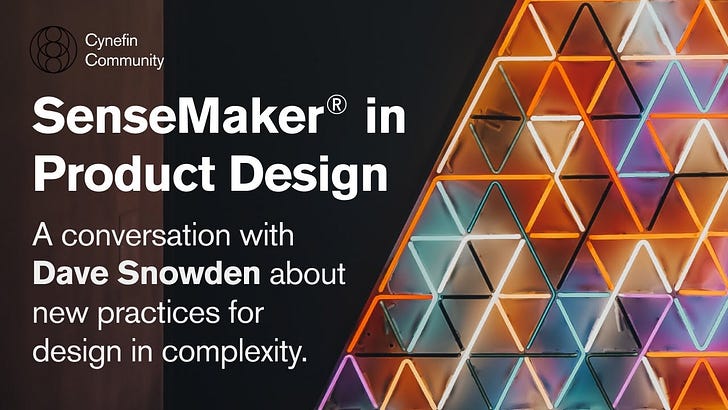How do you generate ideas you couldn’t have had?
A conversation with Dave Snowden about SenseMaker and new practices for design in an increasingly complex world
I’ve spent the past month looking for a new job. This has been a little exhausting, but mainly fascinating. I’ve loved having the opportunity to talk with lots of product and leadership teams about their goals, obstacles and ways of working.
I was surprised to realise they’re all dealing with a similar pattern of issues.
The way most companies have been doing design over the past decade or so — Design Thinking — has reached the end of its lifecycle. It’s been helpful but it’s not designed to handle the ever-increasing complexity in the world.
So what’s next for product design?
That question is why I'm excited to share a conversation I had with Dave Snowden.
You might know Dave from the Cynefin® framework and his work on complexity.
Less well known is his work using a tool called SenseMaker®, and that's what we focus on in this conversation. I think of SenseMaker as a bit like a diary study, but one that connects the dots to make the kind of graphs that businesses can work with. And it does it in real time.
💡 I know it’s really hard to grok what we’re talking about without an introduction. So if you’re interested in the conversation, it’s a good idea to start by watching this 6 minute video. You’ll meet Dave and get the backstory.
Designer Taste Warning: this 10-year old video looks pretty shonky by modern standards. Don’t worry: they’ve redesigned the logo since then 😬
Right, on to the main conversation …
Dave talks about novel ways he’s been helping organisations do discovery and ideation. Not only using the usual teams of expert researchers and designers, but adding “distributed human sensor networks”.
With this approach, we can uncover opportunities we wouldn’t otherwise have spotted. We can generate ideas we couldn't otherwise have had.
Running through the conversation is a case study of Phillips lighting. You’ll hear about the unexpected new product ideas they had when they mapped their customers’ unarticulated needs – instead of asking them direct questions (which doesn’t work).
(As an aside, this obliqueness is one of the things that excites me most about SenseMaker. It kind of “hides” the questions we’re really trying to ask. So when answers pop out of the data, we can be confident that we’re seeing real patterns, instead of respondents just telling us what they think they should say. If this seems frustratingly abstract, I promise it will all make a bit more sense after you’ve watched the interview.)
This is my first time doing an interview like this, and I can’t wait for you to watch!
It’s only half an hour long, and we jump straight into the juicy details.
Afterwards, please do let me know what you thought … Exciting? Confusing? Too beardy? Are you keen to try this out? Do you have questions?
Tom x
Further reading:
cynefin.io : open source wiki with lots more about Cynefin, SenseMaker® and Naturalising Sense-Making
Thanks to John Grant for Zoom and video wrangling, Corissa Nunn for editing, Jorunn and Susan for feedback and — of course — to Dave Snowden.


